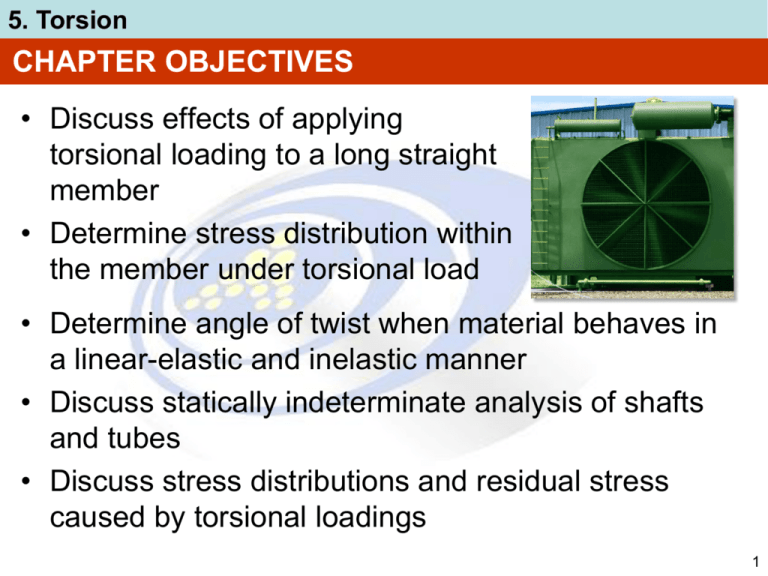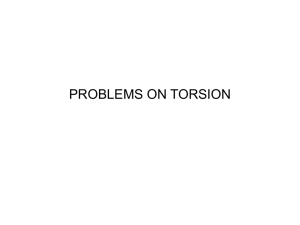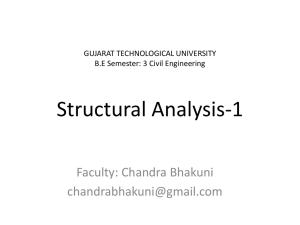
5. Torsion
CHAPTER OBJECTIVES
• Discuss effects of applying
torsional loading to a long straight
member
• Determine stress distribution within
the member under torsional load
• Determine angle of twist when material behaves in
a linear-elastic and inelastic manner
• Discuss statically indeterminate analysis of shafts
and tubes
• Discuss stress distributions and residual stress
caused by torsional loadings
1
5. Torsion
CHAPTER OUTLINE
1.
2.
3.
4.
5.
Torsional Deformation of a Circular Shaft
The Torsion Formula
Power Transmission
Angle of Twist
Statically Indeterminate Torque-Loaded
Members
6. Stress Concentration
2
5. Torsion
5.1 TORSIONAL DEFORMATION OF A CIRCULAR SHAFT
• Torsion is a moment that twists/deforms a
member about its longitudinal axis
• By observation, if angle of rotation is small, length
of shaft and its radius remain unchanged
3
5. Torsion
Shaft Deformations
• From observation, the angle of twist of the
shaft is proportional to the applied torque and
to the shaft length.
T
L
• When subjected to torsion, every cross section
of a circular shaft remains plane and
undistorted.
• Cross-sections for hollow and solid circular
shafts remain plain and undistorted because a
circular shaft is axisymmetric.
• Cross-sections of noncircular (nonaxisymmetric) shafts are distorted when
subjected to torsion.
4
5. Torsion
Shaft Deformations
5
5. Torsion
Shearing Strain
• Consider an interior section of the shaft. As a
torsional load is applied, an element on the
interior cylinder deforms into a rhombus.
• Since the ends of the element remain planar,
the shear strain is equal to angle of twist.
• It follows that
L or
L
• Shear strain is proportional to twist and radius
max
c
and max
L
c
6
5. Torsion
Stresses in Elastic Range
• Multiplying the previous equation by the shear modulus,
G
From Hooke’s Law,
c
G max
G , so
max
c
The shearing stress varies linearly with the radial position in the
section.
• Recall that the sum of the moments from the internal stress distribution is
equal to the torque on the shaft at the section,
T dA
max
c
dA
2
max
c
J
7
5. Torsion
5.2 THE TORSION FORMULA
• The integral in the equation can be represented as
the polar moment of inertia J, of shaft’s x-sectional
area computed about its longitudinal axis
Tc
max =
J
max = max. shear stress in shaft, at the outer surface
T = resultant internal torque acting at x-section, from
method of sections & equation of moment
equilibrium applied about longitudinal axis
J = polar moment of inertia at x-sectional area
c = outer radius pf the shaft
8
5. Torsion
5.2 THE TORSION FORMULA
• The results are known as the elastic torsion formulas,
Tc
T
max
and
J
J
J
1 c4
2
J 12 c24 c14
9
5. Torsion
5.2 THE TORSION FORMULA
• Shear stress at intermediate distance,
T
=
J
• The above two equations are referred to as the
torsion formula
• Used only if shaft is circular, its material
homogenous, and it behaves in an linear-elastic
manner since the derivation is based on
10
5. Torsion
5.2 THE TORSION FORMULA
Solid shaft
• J can be determined using area element in the form
of a differential ring or annulus having thickness d
and circumference 2 .
• For this ring, dA = 2 d
J=
•
2
c4
J is a geometric property of the circular area and
is always positive. Common units used for its
measurement are mm4 and m4.
11
5. Torsion
5.2 THE TORSION FORMULA
Tubular shaft
J=
2
(co4 ci4)
12
5. Torsion
Torsional Failure Modes
• Ductile materials generally fail in
shear. Brittle materials are
weaker in tension than shear.
• When subjected to torsion, a
ductile specimen breaks along a
plane of maximum shear, i.e., a
plane perpendicular to the shaft
axis.
• When subjected to torsion, a
brittle specimen breaks along
planes perpendicular to the
direction in which tension is a
maximum, i.e., along surfaces at
45o to the shaft axis.
13
5. Torsion
5.2 THE TORSION FORMULA
Absolute maximum torsional stress
• Need to find location where ratio Tc/J is maximum
• Draw a torque diagram (internal torque vs. x along
shaft)
• Sign Convention: T is positive, by right-hand rule, is
directed outward from the shaft
• Once internal torque throughout shaft is determined,
maximum ratio of Tc/J can be identified
14
5. Torsion
5.2 THE TORSION FORMULA
Procedure for analysis
Internal loading
• Section shaft perpendicular to its axis at point
where shear stress is to be determined
• Use free-body diagram and equations of
equilibrium to obtain internal torque at section
Section property
• Compute polar moment of inertia and x-sectional
area
• For solid section, J = c4/2
• For tube, J = (co4 ci4)/2
15
5. Torsion
5.2 THE TORSION FORMULA
Procedure for analysis
Shear stress
• Specify radial distance , measured from centre
of x-section to point where shear stress is to be
found
• Apply torsion formula, = T /J or max = Tc/J
• Shear stress acts on x-section in direction that is
always perpendicular to
16
5. Torsion
17
5. Torsion
18
5. Torsion
19
5. Torsion
EXAMPLE 5.3
Shaft shown supported by two bearings and
subjected to three torques.
Determine shear stress developed at points A and B,
located at section a-a of the shaft.
20
5. Torsion
EXAMPLE 5.3 (SOLN)
Internal torque
Bearing reactions on shaft = 0, if shaft weight
assumed to be negligible. Applied torques satisfy
moment equilibrium about shaft’s axis.
Internal torque at section a-a determined from freebody diagram of left segment.
21
5. Torsion
EXAMPLE 5.3 (SOLN)
Internal torque
Mx = 0; 4250 kN·mm 3000 kN·mm T = 0
T = 1250 kN·mm
Section property
J = /2(75 mm)4 = 4.97 107 mm4
Shear stress
Since point A is at = c = 75 mm
B = Tc/J = ... = 1.89 MPa
22
5. Torsion
EXAMPLE 5.3 (SOLN)
Shear stress
Likewise for point B, at = 15 mm
B = T /J = ... = 0.377 MPa
Directions of the stresses
on elements A and B
established from
direction of resultant
internal torque T.
23
Fourth
Edition
MECHANICS OF MATERIALS
Beer • Johnston • DeWolf
Sample Problem 3.4
SOLUTION:
• Apply a static equilibrium analysis on
the two shafts to find a relationship
between TCD and T0 .
• Apply a kinematic analysis to relate
the angular rotations of the gears.
• Find the maximum allowable torque
on each shaft – choose the smallest.
Two solid steel shafts are connected
by gears. Knowing that for each shaft
• Find the corresponding angle of twist
G = 77 GPa and that the allowable
for each shaft and the net angular
shearing stress is 55 MPa, determine
rotation of end A.
(a) the largest torque T0 that may be
applied to the end of shaft AB, (b) the
corresponding angle through which
end A of shaft AB rotates.
© 2006 The McGraw-Hill Companies, Inc. All rights reserved.
3 - 24
Fourth
Edition
MECHANICS OF MATERIALS
Beer • Johnston • DeWolf
Sample Problem 3.4
SOLUTION:
• Apply a static equilibrium analysis on
the two shafts to find a relationship
between TCD and T0 .
© 2006 The McGraw-Hill Companies, Inc. All rights reserved.
• Apply a kinematic analysis to relate
the angular rotations of the gears.
3 - 25
Fourth
Edition
MECHANICS OF MATERIALS
Beer • Johnston • DeWolf
Sample Problem 3.4
• Find the T0 for the maximum
• Find the corresponding angle of twist for each
allowable torque on each shaft –
shaft and the net angular rotation of end A.
choose the smallest.
T0 561 lb in
© 2006 The McGraw-Hill Companies, Inc. All rights reserved.
3 - 26
5. Torsion
5.3 POWER TRANSMISSION
• Shafts are used to transmit power are subjected to torques that
depends on the power generated by the machine and the angular
speed of the shaft.
27
5. Torsion
5.3 POWER TRANSMISSION
• Power is defined as work performed per unit of
time
• Instantaneous power is P = T (d/dt)
• Since shaft’s angular velocity = d/dt, we can
also express power as
P = T
• Frequency f of a shaft’s rotation is often reported.
It measures the number of cycles per second
and since 1 cycle = 2 radians, and = 2f, then
power
Equation 5-11 P = 2f T
28
5. Torsion
5.3 POWER TRANSMISSION
Shaft Design
• If power transmitted by shaft and its frequency of
rotation is known, torque is determined from Eqn
5-11
• Knowing T and allowable shear stress for
material, allow and applying torsion formula,
J
T
=
c allow
29
5. Torsion
5.3 POWER TRANSMISSION
Shaft Design
• For solid shaft, substitute J = (/2)c4 to determine c
• For tubular shaft, substitute J = (/2)(co2 ci2) to
determine co and ci
30
5. Torsion
EXAMPLE 5.5
Solid steel shaft shown used to transmit 3750 W from
attached motor M. Shaft rotates at = 175 rpm and
the steel allow = 100 MPa.
Determine required diameter of shaft to nearest mm.
31
5. Torsion
EXAMPLE 5.5 (SOLN)
Torque on shaft determined from P = T,
Thus, P = 3750 N·m/s
175 rev 2 rad 1 min
=
= 18.33 rad/s
60 s
1 rev
min
(
Thus, P = T,
)(
)
...
T = 204.6 N·m
T
c4
J
=
=
2
2 c allow
c
c = 10.92 mm
Since 2c = 21.84 mm, select shaft with diameter of
d = 22 mm
32
5. Torsion
EXAMPLE 5.6 (SOLN)
33
5. Torsion
5.4 ANGLE OF TWIST
• Angle of twist is important when analyzing reactions
on statically indeterminate shafts
L T(x)
= ∫0
dx
J(x) G
= angle of twist, in radians
T(x) = internal torque at arbitrary position x, found
from method of sections and equation of
moment equilibrium applied about shaft’s axis
J(x) = polar moment of inertia as a function of x
G = shear modulus of elasticity for material
34
5. Torsion
5.4 ANGLE OF TWIST
Constant torque and x-sectional area
TL
=
JG
If shaft is subjected to several different torques, or xsectional area or shear modulus changes suddenly
from one region of the shaft to the next, then apply
Eqn 5-15 to each segment before vectorially adding
each segment’s angle of twist:
TL
=
JG
35
5. Torsion
5.4 ANGLE OF TWIST
Sign convention
• Use right-hand rule: torque and angle of twist are
positive when thumb is directed outward from the
shaft
36
5. Torsion
5.4 ANGLE OF TWIST
Procedure for analysis
Internal torque
• Use method of sections and equation of moment
equilibrium applied along shaft’s axis
• If torque varies along shaft’s length, section made
at arbitrary position x along shaft is represented
as T(x)
• If several constant external torques act on shaft
between its ends, internal torque in each segment
must be determined and shown as a torque
diagram
37
5. Torsion
5.4 ANGLE OF TWIST
Procedure for analysis
Angle of twist
• When circular x-sectional area varies along
shaft’s axis, polar moment of inertia expressed as
a function of its position x along its axis, J(x)
• If J or internal torque suddenly changes between
ends of shaft, = ∫ (T(x)/J(x)G) dx or = TL/JG
must be applied to each segment for which J, T
and G are continuous or constant
• Use consistent sign convention for internal torque
and also the set of units
38
5. Torsion
39
5. Torsion
40
5. Torsion
41
5. Torsion
42
5. Torsion
43
5. Torsion
44
5. Torsion
45
5. Torsion
5.5 STATICALLY INDETERMINATE TORQUE-LOADED MEMBERS
• Assume linear-elastic behavior, and using loaddisplacement relationship, = TL/JG, thus
compatibility equation can be written as
TA LAC TB LBC
=0
JG
JG
• Solving the equations
simultaneously, and realizing that
L = LAC + LBC, we get
LBC
TA = T (
)
L
LAC
TB = T(
)
L
46
5. Torsion
5.5 STATICALLY INDETERMINATE TORQUE-LOADED MEMBERS
• A torsionally loaded shaft is statically indeterminate
if moment equation of equilibrium, applied about
axis of shaft, is not enough to determine unknown
torques acting on the shaft
47
5. Torsion
5.5 STATICALLY INDETERMINATE TORQUE-LOADED MEMBERS
• From free-body diagram, reactive torques at
supports A and B are unknown, Thus,
Mx = 0;
T TA TB = 0
• Since problem is statically
indeterminate, formulate the
condition of compatibility; end
supports are fixed, thus angle of
twist of both ends should sum to
zero
A/B = 0
48
5. Torsion
5.5 STATICALLY INDETERMINATE TORQUE-LOADED MEMBERS
Procedure for analysis
Equilibrium
• Draw a free-body diagram
• Write equations of equilibrium about axis of shaft
Compatibility
• Express compatibility conditions in terms of
rotational displacement caused by reactive
torques
• Use torque-displacement relationship, such as
= TL/JG
• Solve equilibrium and compatibility equations for
unknown torques
49
5. Torsion
EXAMPLE 5.11
Solid steel shaft shown has a diameter of 20 mm. If it
is subjected to two torques, determine reactions at
fixed supports A and B.
50
5. Torsion
EXAMPLE 5.11 (SOLN)
Equilibrium
From free-body diagram, problem is
statically indeterminate.
Mx = 0;
TB + 800 N·m 500 N·m TA = 0
Compatibility
Since ends of shaft are fixed, sum of angles of twist
for both ends equal to zero. Hence,
A/B = 0
51
5. Torsion
EXAMPLE 5.11 (SOLN)
Compatibility
The condition is expressed using the loaddisplacement relationship, = TL/JG.
...
1.8TA 0.2TB = 750
Solving simultaneously, we get
TA = 345 N·m
TB = 645 N·m
52
5. Torsion
5.8 STRESS CONCENTRATION
• Three common discontinuities
of the x-section are:
a) is a coupling, for connecting
2 collinear shafts together
b) is a keyway used to connect
gears or pulleys to a shaft
c) is a shoulder fillet used to
fabricate a single collinear
shaft from 2 shafts with
different diameters
53
5. Torsion
5.8 STRESS CONCENTRATION
• Dots on x-section indicate
where maximum shear stress
will occur
• This maximum shear stress
can be determined from
torsional stress-concentration
factor, K
54
5. Torsion
5.8 STRESS CONCENTRATION
• K, can be obtained from
a graph as shown
• Find geometric ratio D/d
for appropriate curve
• Once r/d calculated,
value of K found along
ordinate
• Maximum shear stress is
then determined from
max = K(Tc/J)
55
5. Torsion
5.8 STRESS CONCENTRATION
IMPORTANT
• Stress concentrations in shafts occur at points of
sudden x-sectional change. The more severe the
change, the larger the stress concentration
• For design/analysis, not necessary to know exact
shear-stress distribution on x-section. Instead,
obtain maximum shear stress using stress
concentration factor K
• If material is brittle, or subjected to fatigue
loadings, then stress concentrations need to be
considered in design/analysis.
56
5. Torsion
EXAMPLE 5.18
Stepped shaft shown is supported at bearings at A
and B. Determine maximum stress in the shaft due
to applied torques. Fillet at junction of each shaft has
radius r = 6 mm.
57
5. Torsion
EXAMPLE 5.18 (SOLN)
Internal torque
By inspection, moment equilibrium about axis of
shaft is satisfied. Since maximum shear stress
occurs at rooted ends of smaller diameter shafts,
internal torque (30 N·m) can be found by applying
method of sections
58
5. Torsion
EXAMPLE 5.18 (SOLN)
Maximum shear stress
From shaft geometry, we have
D 2(40 mm)
=
=2
d 2(20 mm)
6 mm)
r
=
= 0.15
d 2(20 mm)
Thus, from the graph, K = 1.3
max = K(Tc/J) = ... = 3.10 MPa
59
5. Torsion
EXAMPLE 5.18 (SOLN)
Maximum shear stress
From experimental evidence, actual stress
distribution along radial line of x-section at critical
section looks similar to:
60
5. Torsion
CHAPTER REVIEW
•
•
•
•
Torque causes a shaft with circular x-section to
twist, such that shear strain in shaft is
proportional to its radial distance from its centre
Provided that material is homogeneous and
Hooke’s law applies, shear stress determined
from torsion formula, = (Tc)/J
Design of shaft requires finding the geometric
parameter, (J/C) = (T/allow)
Power generated by rotating shaft is reported,
from which torque is derived; P = T
61
5. Torsion
CHAPTER REVIEW
•
Angle of twist of circular shaft determined from
L T(x) dx
=∫
0 JG
•
If torque and JG are constant, then
TL
=
JG
•
For application, use a sign convention for
internal torque and be sure material does not
yield, but remains linear elastic
62
5. Torsion
CHAPTER REVIEW
•
•
•
If shaft is statically indeterminate, reactive
torques determined from equilibrium,
compatibility of twist, and torque-twist
relationships, such as = TL/JG
Solid noncircular shafts tend to warp out of
plane when subjected to torque. Formulas are
available to determine elastic shear stress and
twist for these cases
Shear stress in tubes determined by
considering shear flow. Assumes that shear
stress across each thickness of tube is
constant
63
5. Torsion
CHAPTER REVIEW
•
•
•
Shear stress in tubes determined from
= T/2tAm
Stress concentrations occur in shafts when xsection suddenly changes. Maximum shear
stress determined using stress concentration
factor, K (found by experiment and represented
in graphical form). max = K(Tc/J)
If applied torque causes material to exceed
elastic limit, then stress distribution is not
proportional to radial distance from centerline
of shaft
64
5. Torsion
CHAPTER REVIEW
•
•
Instead, such applied torque is related to stress
distribution using the shear-stress-shear-strain
diagram and equilibrium
If a shaft is subjected to plastic torque, and
then released, it will cause material to respond
elastically, causing residual shear stress to be
developed in the shaft
65







